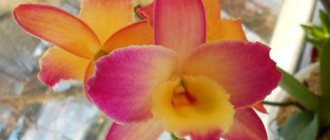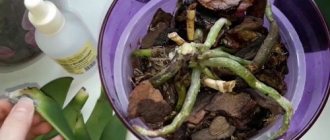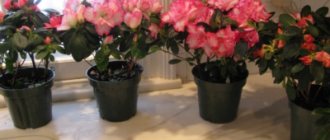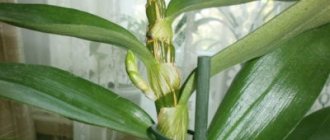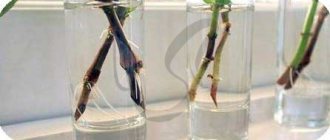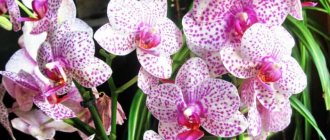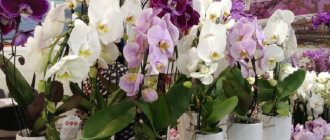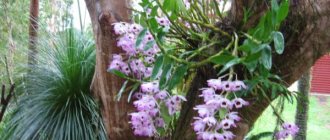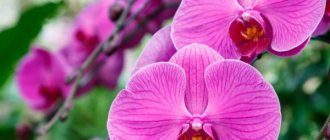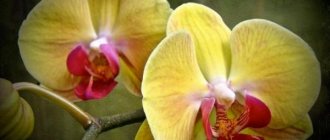Dendrobium phalaenopis extremely popular with orchid lovers, yielding primacy only to various varieties and hybrids of phalaenopsis.
Varieties and hybrids of dendrobium can often be found on store shelves; it is actively used to obtain plants with new color options. The real species Dendrobium phalaenopsis can be found infrequently, however, it is necessary to know its characteristics in order to successfully grow hybrids obtained with its participation.
Description
Dendrobium phalaenopsis forms long spindle-shaped pseudobulbs, at the top of which a peduncle is formed.
The lifespan of a pseudobulb is several years, but after the formation of a peduncle, its growth stops, and a new growth point appears at its base. This type of growth is called sympodial.
The pseudobulb bears leathery leaves , which can persist for several years, especially in the upper part, or fall off after flowering.
The arrows in the photo show the pseudobulbs of Dendrobium lindleyi.
The peduncle grows from the top of the pseudobulb and bears up to 40 flowers with a diameter of 3-5 cm , violet, lilac, white, pink or purple. In shape they resemble phalaenopsis flowers. A few paragraphs later in the article you will find a photo of the peduncle and its care.
Dendrobium orchid: briefly about the flower
Although the flower can be called quite unpretentious, it does not tolerate dry air, excess humidity is also not suitable for it, and it is difficult for the plant to exist in conditions of lack of light.
Dendrobium nobile
- one of the most beautiful varieties of orchids with large, pleasantly smelling buds.
The stem of the plant has certain thickenings called pseudobulbs, which are an accumulation of water and plant nutrients. In the life cycle of orchids there is a pronounced dormant period. At this moment, its growth stops and preparations for a new flowering begin. This happens in winter. The exotic plant can be kept at temperatures as low as + 10 °C with maximum lighting without watering.
If the conditions of proper winter maintenance are met, the plants should sprout flower stalks from the pseudobulb at the end of the season or at the beginning of spring.
Translated from Greek, dendrobium means “tree-dwelling.” That is, this variety of orchids has epiphytic features.
Orchids usually settle on the crowns of trees or other plants. This way they manage to receive more light than those living on the soil. However, orchids do not feed on water or substances from the plants on which they live. Therefore, they are not classified as parasites.
The orchid dendrobium nobile is an evergreen plant with shoots of different lengths, which can have a cylindrical or ribbed shape, as well as a smooth surface. The leaves of most representatives of the species are oblong and narrow-lanceolate; ovate is slightly less common. Most often, the foliage is evenly distributed along the entire length of the stem or concentrated only in its upper part.
Distinctive features
It is difficult to identify distinctive features, because... The height of plants, the number of leaves on pseudobulbs, their life expectancy and the color of flowers can vary greatly. All plants are characterized by leathery dark green leaves, located mainly in the upper part of the pseudobulb.
The number of leaves varies from 3 to 15, depending on the size of the pseudobulbs. At the same time, they grow on the entire stem, which is why Dendrobium phalaenopsis is often called “tree orchids” (you can see the photo below).
Dendrobium phalaenopsis.
Watering during the growth period
Watering is one of the most important stages of care. The dendrobium flower at home must be properly moistened. The first watering after the dormant period should be carried out only after the first signs of vegetative growth appear or when the flower bud ripens.
What is the frequency of water procedures? Water the plant only after the substrate has lightly dried. If the dendrobium grows in the bark, then in the summer it is watered almost every day. To do this, use water purified by a reverse osmosis filtration system and heated to +22-24 degrees. In general, the liquid should be a couple of degrees warmer than the air temperature.
Watering should be done in the morning, and moisture should not get on the foliage, as this increases the risk of fungal diseases. Once a week, gardeners recommend giving a flower a shower. The dendrobium orchid needs to not only wash the foliage, but also the substrate, washing away excess salts from it. Washing the soil is very beneficial for the plant.
Watering the plant is carried out in two ways. You can generously moisten the soil with a watering can or lower the flowerpot with dendrobium into a container of water for 5-10 minutes.
High-quality watering is important for any home flower. Dendrobiums are very sensitive to moisture. How well a plant is watered can be judged by certain signs:
- A flower needs moisture if its roots have a silvery tint.
- After a good watering, the root sheath takes on a glossy green color.
- The next water treatment is given to the plant only after the roots become silver again. Their color is the main indicator of the need for watering.
Subtleties of classification
An interesting fact is that this species has become widely known under a name that is actually synonymous with its real name. This type of orchid was first discovered in 1852 and was named Dendrobium bigibbum, but thirty years later (in 1880) another researcher also discovered a plant of this species in another region and, not knowing about the previous discovery, named it Dendrobium phalaenopsis (Dendrobium phalaenopsis).
On a note! The term Dendrobium phalaenopsis has now become an impersonal name for a huge group of hybrids, similar in external structure, type of growth and originating from D. bigibbum. The real species name is known mainly to collectors.
Species dendrobiums at home: growing secrets
If you want to dive even deeper into orchid culture, you can try purchasing species plants. However, remember that they will require more attention than resistant hybrids specially bred for growing in average conditions.
Dendrobium dense-flowered
Dendrobium densiflorum is a very beautiful species with dense multi-flowered inflorescences consisting of large fragrant bright yellow flowers. Quite a large plant that requires a lot of space. In the summer you can take it out onto the balcony or keep it in the garden.
Dendrobium is unique
Unique Dendrobium (Dendrobium unicum) is a miniature plant with a pronounced periodicity in development. The flowers are bright orange with a lighter lip. Quite difficult to grow.
Dendrobium Parisha
Dendrobium parishii is another miniature species not for lazy people. The flowers are shiny, rich pink in color with a caramel scent. When growing, a pronounced temperature periodicity is required (cool and dry winters, hot and humid summers, with a decrease in temperature at night).
Dendrobium odorless
Dendrobium anosmum is an epiphyte widely distributed in Southeast Asia. Popular hybrid from d. anosmum – Superbum with larger (up to 8 cm) and much brighter fragrant flowers. It can bloom at any time of the year, with peak flowering at the end of winter. It is interesting that orchidists evaluate its smell differently: some think it smells like bananas, others recognize the aroma of raspberries, and others even smell rhubarb. On the other hand, it is known that orchids can indeed smell differently and even change their aroma during the flowering period.
Dendrobium leafless
Leafless Dendrobium (Dendrobium aphyllum) is an epiphytic (on trees) or lithophytic (on rocks) species, widespread in Southeast Asia. Each flower reaches 3–5 cm in diameter. The main peak of flowering occurs in February–May, but flowering specimens can be found in cultivated conditions almost all year round. Refers to a moderately warm temperature regime. In the summer, it is better to take the plant out into the open air. A natural drop in night temperature will stimulate further flowering.
Dendrobium bihump
Dendrobium bigibbum is a popular orchid from Australia and New Guinea. There is currently debate whether Dendrobium bihump and Dendrobium phalaenopsis (moth) are one species or are two separate independent species. The most common version is that Dendrobium phalaenopsis is a form of Dendrobium bigibbum subsp. phalaenopsis. Peak flowering occurs in autumn.
It is not advisable to take it out into the open air.
Is there a difference between Phalaenopsis and Dendrobium?
The specific species name often discourages flower growers who are not familiar with the intricacies of the classification of orchids. Dendrobium and Phalaenopsis are actually 2 different genera of orchids , each with a huge number of species.
Dendrobium phalaenopsis is a member of the genus Dendrobium, and it received its specific name not because of its relationship with phalaenopsis, but because of the similar appearance of the flowers.
In addition, due to the similarity in pronunciation, dendrobium is sometimes mistakenly called “arboretum”. To avoid confusion, let's say that an arboretum is an area allocated for the cultivation in open ground of woody plants (trees, shrubs, vines), located according to systematic, geographical, ecological, decorative and other characteristics (definition from Wikipedia). That's why you will never see orchids in the arboretum, even in photos.
Dendrobium transplant
Having bought a blooming orchid, do not rush to replant it; it is better to wait until the end of flowering. Overgrown roots indicate the need for replanting.
Dendrobium does not need spacious containers. He is quite comfortable in a small plastic pot with a good drainage layer, hanging in a basket, on a block.
Transplantation is usually carried out in the spring, after 3-4 years. Be careful not to cover the buds at the base of the shoots with soil. It is advisable to refrain from watering for about a week due to injury from root transplantation. Light spraying is acceptable.
The soil should be loose, consisting of natural organic elements. Prepare the following substrate from crushed parts: pine bark, a little charcoal, sphagnum moss or osmunda fern roots, coconut fiber. Drainage is placed at the bottom of the pot, which consists of expanded clay of large and medium fractions. This will help protect the plant from constant waterlogging and rotting of the root system. Coal prevents acidification of the soil mixture.
External characteristics
The height of an adult plant can vary depending on the size of the pseudobulbs . In some specimens, the height of the pseudobulb does not exceed 10 cm, while in others it can reach 120 cm. If we add to this height the height of the peduncle, which can reach a length of 40 cm, it turns out that some specimens in a flowering state can be more than 1.5 m in height.
Most often you can find intermediate options. As the plant ages, the height of the pseudobulbs increases, as well as the length of the peduncle and the number of flowers on it.
The leaves are leathery, 7-15 cm long. In the lower part of the pseudoulba, the leaves are smaller and fall off quickly, and in the upper part they can persist for 2-3 years. Depending on the size, each pseudobulb can have from 3 to 15 leaves.
The peduncle can be either erect or drooping. Up to 20 flowers can form on it At the same time, in some plants several peduncles can form from the top at once.
The diameter of the flowers of the species dendrobum phalaenopsis is 3-5 cm . In the structure of the flower, the shape of the sepals, petals and lips, the dendrobium is very similar to phalaenopsis.
Dendrobium resembles phalaenopsis in flower structure.
What you need to know about transplanting, feeding and propagating flowers
Everyone is accustomed to the fact that indoor plants should be replanted regularly. This is true, but this rule does not apply to phalaenopsis. They are transplanted only when necessary.
Important! If a flower is replanted unnecessarily, it may begin to disappear.
Transplantation is carried out if the plant becomes crowded or the root system begins to rot. During this manipulation, dried and old bulbs are removed, as well as some dead roots.
As for fertilizing, it is applied no more than once every 15 days. For these purposes, special fertilizers for orchids are purchased. It is impossible to feed frequently, because the flower may begin to hurt. Everything should be in moderation.
If you want to propagate phalaenopsis, then you should know that the process is possible with the help of children that are formed on pseudobulbs. By the way, when the gardener notices that the orchid’s root system is already quite well developed, he can carefully cut off this very baby from the mother plant, dry it, and then plant it in a separate container. The growth of a young flower will directly depend on the baby; the stronger it is, the faster it will begin to form a full-fledged orchid.
Main features of flowering
Under optimal conditions and moderate temperatures, flowering of a species plant can last from 1 to 3 months . When it comes to hybrids, flowers on some hybrid plants can stay in bloom 2 times longer.
In apartment conditions, flowering usually occurs at the beginning of spring , after a relatively dry and cool dormant period. However, hybrid plants can bloom at any time of the year.
Theoretically, each pseudobulb can bloom several times, even after it completely loses its leaves, but in species plants the peduncle is formed only from the tip of the pseudobulb, even with repeated flowering.
Interesting! In hybrid plants, in the creation of which not only D. bigibbum took part, peduncles can also form from the leaf axils in the upper part of the pseudobulb.
Stimulation
Hybrid plants, as a rule, do not have problems with flowering, but species specimens need a short period of rest , as in natural conditions.
During the dormant period, plant growth stops and new growths and roots do not form. At this time, it is necessary to keep the dendrobium drier than usual , i.e. reduce the frequency of watering and eliminate fertilizing.
Pruning after flowering
After the last flower falls, the peduncle usually dries up. Since it no longer plays any role in the life of the plant, it is cut down to the level of a pseudobulb .
After flowering, the peduncle is cut to the level of the pseudobulb.
Possible diseases and pests
Plants, like people, can periodically encounter diseases, the nature of which can be infectious or non-infectious. The main factor provoking their occurrence is improper care. Below we will consider what diseases most often develop in dendrophalaenopsis and how to treat them.
Rules for controlling diseases and pests
Diseases:
- Fusarium. First, the disease affects the roots, then the entire flower. The reason is excess water. Treatment is impossible.
- Hives - causes damage to the leaves, resulting in the formation of large spots on them. Reasons: incorrect temperature (too cold) and humidity, poor ventilation. How to treat - get rid of errors in content.
- Botrytis. The reason is poor ventilation. The disease is accompanied by the formation of dark spots on the petals, causing them to fade. How to treat - eliminate deficiencies in care.
Non-infectious diseases appear as a result of excessive lighting, improper fertilization, watering, and are characterized by dry ends of the leaves and necrosis of the roots. How to treat - eliminate the cause.
Pests:
- Mealybug. When this pest attacks a plant, its leaves turn yellow and fall off. You can cure it by treating the orchid with a soap solution.
- Spider mite. Silvery threads of cobwebs appear on the leaves of the flower. You can try to get rid of the pest using a soap solution. If it doesn’t help, resort to acaricides.
- Thrips. Infection is accompanied by the formation of brown spots on the leaves. Actellik or other systemic insecticides will help.
- Shield. Causes damage to the orchid by sucking the juice out of it. The presence of unwanted guests will be indicated by tubercles on the leaves. Treatment method: two-phase treatment with soap solution once a week.
- Slugs. These pests gnaw the flower. To get rid of them, you should put 2-3 pieces of cucumber or carrots in the substrate. When a slug crawls onto a vegetable, remove it.
Features of care
Dendrobium phalaenopsis is quite unpretentious and, subject to optimal maintenance conditions, does not cause significant trouble to the owner . Hybrids tolerate indoor conditions quite well.
Optimal conditions for keeping
This species and the hybrids obtained from it are classified as warm-keeping . In the natural habitat, the climate is quite hot and precipitation is more or less regular. Although a pronounced period of drought is also present.
Temperature
It is believed that for species plants the optimal daytime temperature should be from 28°C to 32°C, and night temperature - from 23°C to 26°C. Hybrids grow best at lower temperatures ranging from 18°C to 24°C.
Under these conditions, the plant will constantly form new shoots and bloom without problems.
However, the plant is able to withstand temperatures that are far beyond the temperature optimum: from 10°C to 42°C.
Plants can tolerate such extreme temperatures for orchids for a short time without harm to health, but they will not be able to constantly survive in such conditions.
Important! At any temperature (warm or moderate), it is important to ensure a difference of 5...6°C between day and night temperatures.
Humidity
Species orchids require high air humidity, 60% or more , but hybrids are less demanding and can tolerate less humidity. However, air humidity also plays an important role in plant growth and the likelihood of flower stalks appearing.
Light
The lighting intensity should be high enough. Dendrobium phalaenopsis easily tolerates direct sunlight , except midday in the summer, although it can adapt to it. North-facing windows may suffer from a lack of light, and in winter it is advisable to provide the plant with additional lighting.
Lighting is an important aspect in caring for orchids at home (phytolamp photo).
Landing
In apartment conditions , it is better to prefer planting on a block to prevent the roots from quickly drying out. Of course, a block planting option is also possible, but then it is necessary to maintain very high air humidity, which is quite difficult in an ordinary apartment.
When choosing a pot, you should take into account the massiveness of the plant . Large plants can turn over light plastic pots after the substrate dries out. In this case, for tall specimens, we can recommend special clay pots for orchids.
A mixture of coniferous bark and charcoal can be used as a substrate . Some growers also add coconut chips or other ingredients. Including perlite or pieces of foam to increase the breathability of the substrate.
If the humidity in the room is low or the exposure is southern you can add moss to the substrate to increase its moisture capacity.
Transfer
It is recommended to replant every 2-3 years , unless there is an urgent need to replace the substrate. However, replanting after purchase in a store is required if the plant has already bloomed.
When choosing the optimal time for transplantation, it is necessary to take into account the condition of the plant. It is best to replant when the dendrobium has begun to form new growth , because... Young roots form and grow quickly on it, which will help the freshly transplanted plant quickly gain a foothold in the new substrate.
Dendrobium phalaenopsis should be replanted when young roots appear.
Watering and fertilizing
The frequency of watering depends on the moisture capacity of the substrate, the conditions of the plant and the drying rate. The substrate should dry out between waterings, but the roots should not dry out.
Important! Feeding is carried out 2-3 times a month. When choosing a fertilizer composition, it is necessary to take into account the stage of plant development. During the growth of new shoots and elongation of pseudobulbs, the plant has a higher need for nitrogen.
When growth has stopped and the pseudobulb has formed, you need to reduce the nitrogen concentration and give preference to phosphorus-potassium fertilizers, which are necessary for flowering.
Prevention of diseases and pests
Dendrobium phalaenopsis is affected less frequently by pests and diseases than other types of orchids , but basic preventive measures must be observed:
- be sure to inspect purchased plants, carry out preventive treatment and keep them for some time separately from other indoor flowers;
- observe the watering regime to prevent waterlogging of the substrate and death of the roots.
How to make Dendrobium bloom?
The lack of flowering of an orchid is usually associated with improper care and uncomfortable conditions for it. Stimulation is effective in the spring, immediately after the active growth phase.
It is necessary to increase the intensity of lighting and the duration of daylight hours. The orchid is placed in the brightest place and illuminated with a phytolamp.
The main rule of periodic flowering is the daily fluctuation of day and night temperatures - the limit is 5-6℃. From time to time the plant is given a good drying.
2-3 times you can take a warm shower with a water temperature of 30-35°. Watering before flowering is reduced.
Following these simple rules will stimulate the lush flowering of dendrobium.
Fertilizing to stimulate flowering is sufficient, but not excessive. Nutrition is organized in accordance with the phases of the plant’s life cycle:
- Growth of young stems - fertilizer with a predominance of nitrogen / “Agrecol for orchids”.
- Thickening of pseudobulbs - sparser, with a weak solution of balanced fertilizer / “Fasco for orchids”
- The appearance of a peduncle - fertilizer with a predominance of phosphorus and potassium / “Pokon for orchids”
- Addiction to nitrogen-containing additives has a bad effect on the development of flower stalks. If these drugs are applied too often, the orchid does not bloom as actively.
- Care after flowering goes into another stage.
Growing problems
Despite the relative ease of the species, certain difficulties with its maintenance may still arise. Most often they are associated with root loss and flowering.
Resuscitation of dendrobium without roots
If the roots are completely lost, it is better to remove the plant from the pot, remove all rotten roots, treat the damage and place it on a sphagnum substrate.
Plants without roots are sprayed and fed leaf by leaf to prevent leaves and pseudobulbs from wrinkling. The plant is kept in this form until new growth appears. It is on the new growth that roots will form.
After they have grown a few millimeters, the plant can be placed in a pot with a substrate, tied to a support so that the dendrobium does not stagger and injure the young roots.
The roots will quickly increase in size and master the substrate. To stimulate root growth, the surface of the substrate must be periodically sprayed.
Dendrobium without roots.
No flowering
If the plant refuses to bloom, it is necessary first of all to analyze the conditions of maintenance and care. Perhaps to stimulate flowering it is enough to simply reduce the night temperature or provide additional lighting.
Reproduction
Dendrobium phalaenopsis is propagated vegetatively: by dividing the bush and cuttings. The shoots are separated along with the roots and placed in a separate container and watered. This procedure is quite painful for the plant. In addition, if you choose this method, you should not count on flowering in the near future.
Usually, after the phalaenopsis dendrobium has bloomed along the entire height of the mother pseudobulbs, children may appear. As soon as they grow and the length of their roots reaches 5-7 cm, they are carefully separated with a knife and the cut site is sprinkled with coal. It may happen that the children, just like an adult full-fledged bulb, can release buds and bloom in small quantities due to the forces of the mother plant. In this case, you need to wait until they bloom, and only then separate them from the pseudobulbs.
Then we take small plastic pots and prepare the substrate for planting. As planting material, you can use mostly fine pine bark and, to a lesser extent, in equal parts: small pieces of charcoal and sphagnum moss. We mix all this and plant the shoots without deepening them into the substrate.
At first, you need to provide young plants with high humidity. It is recommended to spray only the upper part of the substrate, avoiding the stems in order to prevent them from rotting. Watering should be regular. The soil mixture should always be moist, but you need to ensure that the water does not stagnate in the pot. Only three weeks after the young plants have become stronger can you begin to feed them with complex fertilizers.
In the case of cuttings, the procedure is carried out as follows: the pseudobulb is separated from the bush and cut into cuttings of the same length. Each cutting is placed in cellophane with moss inside until roots appear. In order for the roots to begin to form, the moss is regularly moistened and the cuttings are ventilated. The cuttings will take root after 15–20 days, after which they can be planted in separate pots. The bushes grown from them will bloom for the first time after 2 or 3 years.
Popular varieties and hybrids
Currently, there are a huge number of varieties of phalaenopsis dendrobium , which differ in the shape and size of pseudobulbs, diameter, shape and color of flowers.
More often than others on store shelves you can find hybrids of the Emma series:
- Emma Gold with yellow petals and burgundy lip;
- Emma Queen with bright lilac petals;
- Emma White with snow-white flowers;
- Emma Green with green petals and purple lip.
No less popular is the variety with green flowers Anna Green.
variety has a very delicate flower color . When blooming, the slightly greenish petals turn white, and light lilac strokes are clearly visible on the lip.
Emma Gold.
Emma Queen.
Emma White.
Emma Green.
Anna Green.
Snow jade.
Humidity.
In general, dendrobium phalaenopsis is not demanding of high humidity. Spraying will be required only in the summer heat, and again only in the first half of the day. Do not spray when direct sunlight falls on the plant. If it is not possible to spray in the morning, then it is better to avoid it altogether. Fresh air is useful, ventilate the room more often. At the same time, drafts and sudden cooling of the orchid are unacceptable. This can happen in winter.
